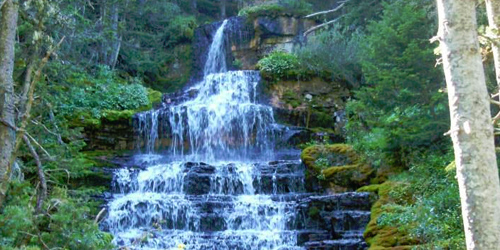Crystal Cascades Trail

Overview: Crystal Cascades Trail, below Crystal Lake in the Snowy Mountains, meanders back and forth along Rock Creek, climbing steadily until suddenly revealing a 100-foot tall waterfall formed when the creek emerges from a cave and cascades out and down over a rock cliff.
Distance and difficulty: According to trail signs and hiking time, the trail is approximately 3.5 miles one way, or about 7 miles out and back. The trail gains approximately 1,000 feet in elevation from the trailhead to the falls. This trail is rated Intermediate.
The trail, for the most part, is easy to follow; however there are multiple stream crossings (we counted more than 15) requiring hikers to navigate across logs or slick, wet rocks. In addition, while the trail itself has a forgiving, compacted earth surface, every few feet are toe-catching rocks or roots just waiting to trip the distracted hiker.
Some parts of this trail are rather steep, and a few spots require clambering over large boulders. This is not a good hike for those with mobility issues or for young children, unless they can be carried.
Directions: The Crystal Cascades trailhead is easily located off Crystal Lake Road, a couple of miles below the lake. From Lewistown, take Highway 87 toward Great Falls. Look for the sign for Crystal Lake Road approximately 8.7 miles from town; turn left on Crystal Lake Road, which is unpaved. Stay on Crystal Lake Road to the Lewis and Clark National Forest boundary, where the road becomes paved. Follow the paved road toward Crystal Lake; look for the sign for Crystal Cascades trailhead. Turn left into the paved parking lot.
Trailhead: The trailhead is at the far end of the parking area and is clearly marked with a wooden sign. The parking lot is large, accommodating at least 10 vehicles. There is a vault toilet. While this hike follows Rock Creek for nearly the entire 3.5 miles, it is not recommended to drink the creek water. Hikers should carry their own water.
Description: Just beyond the parking area the trail enters spruce-fir forest, and begins to follow Rock Creek. If you are hiking in mid- to late-summer or fall, the creek will be dry from the trailhead for approximately the first mile or so. The trail runs through dense forest with fairly heavy undergrowth.
It is almost entirely shaded, which makes it a great hike for a hot summer’s day, but on cooler days a jacket is recommended. Hikers will want to wear sturdy shoes and long pants - the trail is nearly overgrown in spots with brush of all kinds, including wild berry bushes and roses. It can be a little thorny!
As the trail starts to climb, it also begins to switch back and forth from one side of the creek to the other. If you are hiking in the summer or fall when water levels are lower and the creek goes underground, crossing is a simple matter of picking one’s way around the boulders or across smooth bedrock.
Further up, where the creek is still flowing above ground, crossing means hopping from large rock to large rock and hoping they are stable. In the early part of the summer, most if not all of the crossings will be wet. Use caution: the rocks are slicker than they look and it is easy to loose footing as you cross.
A stout wood hiking staff is a handy tool for this trail . You may also want to carry a spare pair of shoes and socks, if you don’t like wet feet. This trail has a lot to offer for nature lovers. With abundant water and food sources, there are plenty of birds, squirrels and chipmunks to accompany hikers. Birds seen along the trail include dippers, mountain chickadees, juncos, warblers, flickers, robins, woodpeckers, and nuthatches.
The forest is a riot of wildflowers in the spring and early summer, including wild roses, wild geraniums, bee balm, purple asters, bluebells of Scotland, clematis, violets, and honeysuckle.
The fall season is almost as colorful due to the numerous maples and other colorful foliage. Wild berries include raspberries and thimble-berry. About a mile and a half up the trail, the creek flows over lengthy flat stretches of algae-covered bedrock, perfect for sliding if you are careful about how you get to and from the slide rocks.
At the two-mile mark the trail begins to climb up and away from the edge of the creek, and then back down. There are two or three repeats of this in the next mile, and some of the climbs are a bit steep. At three miles in, the trail splits. There is clear signage at the “Y” intersection, with the right-hand branch heading to Crystal Lake (3 miles away) and the left-hand branch leading to the cascades (.5 miles).
The trail climbs up from the “Y” for a short distance, flattens out a bit, and then, suddenly, the waterfall appears. Rock Creek flows out of a cave about 100 feet above the trail, spills over the cliff edge and cascades down a series of rock ledges.
The official trail takes the hiker just to the bottom of the falls. The cliff face at the falls is covered with moss and wildflowers, and if it is a sunny day, the waterfall glistens like crystal. The bedrock at the bottom of the cliff makes a great seating area for lunch or to watch the water endlessly showering down.
An unofficial trail, very steep and requiring very careful climbing, leads up the side of the cliff to the mouth of the cave and the origin of the falls. This part of the hike is rated Advanced. The view from the top is spectacular, if you don’t mind heights. To return to the trailhead, simply reverse direction. Because the trail is nearly all downhill on the way back, hikers can expect a much quicker return trip.
Please note: that while every effort has been made to guarantee accuracy in trail descriptions, errors in recording mileage and trail conditions can occur. Also changes occur on the land; some descriptions that were accurate when written may be inaccurate later. One storm, for example can block a road or trail. The responsibility for good health and safety while hiking is that of the user.
Ratings: Hikes are rated as beginner, intermediate and advanced. Beginning hikes are those which are mostly flat or with only short stretches of steep grades, and with well-marked, easy to follow trails. Intermediate hikes are those with very steep or very long grades, or with trail surfaces which are somewhat unstable. Advanced trails are those with very steep, or very unstable trails, those that require some climbing or those which are not well-marked or which contain stretches of off-trail hiking. None of these hikes requires technical climbing. Hikers should adjust these ratings for their own fitness and experience levels.


Crystal Cascades Trail